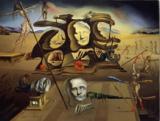Istanbul, 19 september 2008
The Sakip Sabanci Museum in Istanbul, Turkey, standing on a magnificent site on the Bosporus, will be running the exhibition Salvador Dalí, a Surrealist in Istanbul, which will be on show from 20 September to 30 January 2009.
Background and context
The Dalí Foundation is organising an exhibition featuring the largest number of works from its collection ever shown away from its own premises, and is very pleased at having succeeded in arranging a project of this scale in one of the world's main cultural capitals. It was joined by top-rank partners in that venture: the Sakip Sabanci Museum and Akbank, two of the leading business groups in the country. Both institutions feature an extremely high degree of technical and professional excellence, and that has enabled this project to be successfully concluded: this exhibition is a great opportunity for making Salvador Dalí and his work better known throughout the country, particularly in academic and school spheres.
The history of the Sakip Sabanci Museum
The museum is located in the Emirgan, one of the oldest settlement sites on the Bosporus. In 1927, Prince Muhammad Ali Hassan, from the Egyptian Hidiv family, commissioned the Italian architect Edouard De Nari to build a villa for use as a summer residence for the Hidiv family. It housed the Montenegro Embassy for some time, and is now the museum's main building. It was acquired in 1950 by the industrialist Haci Ömer Sabanci, who baptised it “The Mansion of the Horse” after the sculpture standing in the garden – a work by the French sculptor Louis Doumas. A second horse was added: one of the four horses in Sultanahmet square in Istanbul, which had been saved from the 1204 crusades, and was later taken to Saint Mark's Basilica in Venice. When Haci Ömer Sabanci died in 1966, the villa was taken over by the family's eldest son, Sakip Sabanci, who housed the family's art collection there. In 1998, Sabanci University took over the collection and furniture and turned the villa into a museum. A new gallery was added to the original building, and it was opened as a museum in 2002. Extension work was done in 2005. Since then it has been showing its magnificent collection of paintings to the public (mainly works by local artists from the period 1850 to 1950) plus examples of Ottoman calligraphy. It has also put on temporary exhibitions in its premises, such as the one devoted to Picasso in 2007, and abroad too, such as with the exhibition of Ottoman calligraphy dating from the fifteenth to the twentieth century, put on in the Real Academia de las Bellas Artes in Madrid and in the Real Alcázar in Sevilla, from April to June that year. The Sakip Sabanci Museum is becoming one of the chief museums in Turkey, and a platform through which great international artists can introduce themselves in this country.
Akbank
It was founded in Adana in 1948, originally with the mission of financing the region's cotton producers. By the end of 2007, Akbank ranked first among Turkey's most profitable private banks. With 60 years' experience behind it, Akbank has emerged as a catalyst for developing art and culture in the country. Its community work has materialised in the form of projects such as the Akbank Sanat art centre, a clear example of the arts-sponsoring work the bank is undertaking.
Its president, Suzanne Sabanci, played a key role in the negotiations with the Dalí Foundation for taking Dalí over to Turkey. She took a personal interest in the Dalí project, since it is in line with the innovative approach pursued by the financial group over recent years.
The exhibition's content
This is the first exhibition showing a very large number of works from the Gala-Salvador Dalí Foundation's collection to have been put on away from the Foundation's own premises. It involves nearly 300 works — 30 oil paintings, 114 drawings, 111 engravings and 12 lithographs —, as well as a range of graphic documents and supplementary materials. It is a selection of prominent works from Dalí's long artistic career, showing the various styles he cultivated, stemming from his mastery and his theoretical and practical knowledge of the history of art. We are also presenting a multi-faceted Dalí, through very well-known works: Table beside the Sea, Homage to Erik Satie, Surrealist Composition with Invisible Figures, Napoleon's Nose Transformed into a Pregnant Woman Melancholically Walking her Shadow amidst Original Ruins, Intraatomic Equilibrium of a Swan's Feather, Dalí from the Back Painting Gala from the Back..., Dematerialization near the Nose of Nero, and others which, while less well known, are of considerable interest, such as Jóncols Cove. Cadaqués (1920), Plant with Flowerpot (c. 1923), Portrait of Mr. Emilio Terry (1934), and Untitled. Double Image with Horse, Numbers and Nails (c. 1960). This exhibition is both retrospective and innovative, and it is rounded off with drawings and graphic work (engravings and lithographs) that firmly place Dalí as one of the great painters and drawers of the twentieth century.
Acknowledgements
Salvador Dalí, a Surrealist in Istanbul was organised by the Gala-Salvador Dalí Foundation (Figueres), in conjunction with the Sakip Sabanci Museum and with the sponsorship of Akbank. The catalogue was produced by Montse Aguer, director of the Centre for Dalinian Studies at the Gala-Salvador Dalí Foundation and a patron of the institution, and it was published by the Sakip Sabanci Museum.






